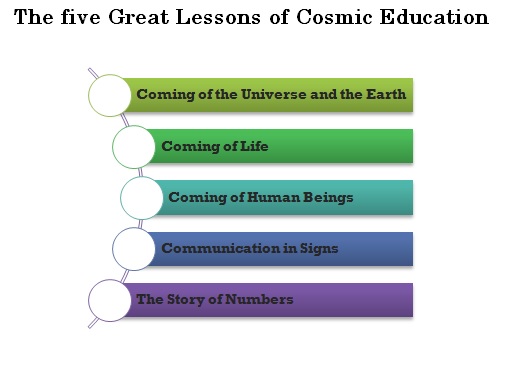Cosmic Education In Montessori Elementary School
30th July 2021

The Five Great Lessons or popularly known as Cosmic Education of Montessori curriculum is a broad, exciting, and stirring concept that is introduced in lower elementary school. Montessori teacherspresent these lessons to grade 1 to 3, these lessons are presented every year to ensure children are able to go back to the lesson multiple times, leaving them enough room to discover and rediscover as they grow.
The concept of the cosmic approach developed by Mari Montessori aims to help children find joy in learning, ingrain curiosity through asking the big questions.Generally, in Elementary School Teaching, children are introduced to the small ideas and gradually move to the larger concept. In Montessori, the five great lessons are the initiation to children learning process, an inspiring method to look at and rethink children’s education.
The 1st Great Lesson – Coming of the Universe and the Earth
The first great lesson from cosmic education speaks about the big question ‘creation of the universe’, mainly done on the first day of school. The lesson comprises demonstrations, experiments, and storytelling to cover the big question of how the universe was created. The lesson encompasses subjects like physics, chemistry, astronomy, geography, geology, and meteorology.

The 2nd Great Lesson – Coming of Life
The second great lessons revolve around how life was created on earth. The timeline of evolution that brought us to where we are at present. This part is an exciting lesson to practice with the lower elementary kids. Through guided exploration on evolution, diversity, and interconnection of living beings, the lesson studies biology, botany, habitats, and zoology.
The 3rd Great Lesson – Coming of Human Beings
Coming to the next great lesson is all about how humans evolved since their inception. This lesson sheds light on how special humans are – the skills and gift that makes human different from other animals. This lesson helps children to discover how humans have met their basic needs, how the human mind is imaginative, and how it has expanded over the timeline. The lesson leads to the study of history, culture, invention, and social studies.
The 4th Great Lesson – Communication in Signs
In this lesson, students learn about the development of written language. Humans have always used communication to express themselves. They used pictures, symbols, and language to communicate with each other. Students study about the written alphabet – reading, writing, language, and structure. Students learn about the history of language and how language has evolved over time.
The 5th Great Lesson – The Story of Numbers
The story of numbers also called the history of mathematics is the fifth lesson of cosmic education. This lesson begins by describing the way ancient culture communicated numbers before the modern number system was discovered. Much similar to the story of writing i.e. fourth great lesson, this helps learners to dive deep into the subjects like mathematics, number system, geometry, and the history of numbers. Students also learn about the functional use of numbers, the idea of 'zero', and its importance.
In a Montessori setting, the scope of organic learning is enormous. Maria Montessori believed “The greatest sign of success for a teacher is to be able to say, ‘The children are now working as if I did not exist.’ We teachers can only help the work going on, as servants wait upon a master.” – A wonderful way to describe the true role of the teacher in children's life.
Montessori teachers are known to be the facilitator of learning. Children are respected as an individual, their pace of learning and their interest on that what they want to learn revolves around self-discovery. The five great lessons are the core of Montessori Elementary School Teaching. These lessons allow children to explore the world around them and how humans are all interconnected. It also helps to orient themselves in subjects. Starting from discovery to revelation to complex thinking, the 5 great lessons encompass broader aspects of foundational education.
Written By : Nilesh Singh











